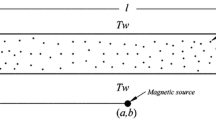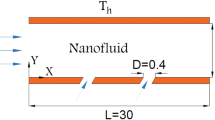Abstract
In this study, heat transfer and entropy generation were investigated in a microchannel containing FMWNT/water nanofluids given the slip condition. The main focus was on utilizing injection technique in the presence of the magnetic field. The injection from the upper high-temperature wall was incorporated into the flow field. Injection at high Reynolds number causes vortex formation, which ultimately reduces local heat transfer in the adjacent injection zone. By applying the magnetic field, the vortex intensity as well as boundary layer thickness was diminished which in turn improved the heat transfer. Based on numerical results, at higher nanoparticle volume fraction, the effect of the magnetic field on heat transfer enhancement was amplified. Moreover, at higher Reynolds numbers, the magnetic field efficacy is more obvious. The highest heat transfer occurred at the highest values of the Hartmann and Reynolds numbers and eventually the nanoparticle volume fraction. Owing to applying the magnetic field on the injectable microchannel containing nanofluid, heat transfer improvement can reach up to 79%. From the second law prospective, the entropy generation intensified by 82.8%.












Similar content being viewed by others
Abbreviations
- B o :
-
Magnetic field strength (T)
- h :
-
Microchannel height (mm)
- H :
-
Dimensionless microchannel
- Ha:
-
Hartmann number
- l :
-
Microchannel length (mm)
- L :
-
Dimensionless microchannel
- \(\bar{p}\) :
-
Pressure (Pa)
- Re:
-
Reynolds number
- \(\dot{S}_{\text{f}}\) :
-
Viscous entropy generation
- \(\dot{S}_{\text{h}}\) :
-
Thermal entropy generation
- \(\dot{S}_{\text{t}}\) :
-
Total entropy generation
- U :
-
Dimensionless horizontal velocity
- u s :
-
Slip velocity \(\left( {\frac{{{\text{m}} }}{\text{s}}} \right)\)
- U s :
-
Dimensionless slip velocity
- S r :
-
Ratio of total entropy with magnetic field to total entropy without magnetic field
- \(\beta\) :
-
Slip coefficient (mm)
- \(\beta^{*}\) :
-
Dimensionless slip coefficient
- \(\varphi\) :
-
Volume fraction of nanoparticles (%)
- θ :
-
Dimensionless temperature
- \(\alpha\) :
-
Thermal diffusivity \(\left( {\frac{{{\text{m}}^{2} }}{\text{s}}} \right)\)
- \(\sigma_{\text{nf}}\) :
-
Nanofluid electrical conductivity \(\frac{{\rm{S}}}{{{\rm{cm}}}}\)
- ave:
-
Average
- h:
-
Hot
- c:
-
Cold
- nf:
-
Nanofluid
References
Shiriny A, Bayareh M. On magnetophoretic separation of blood cells using Halbach array of magnets. Meccanica 2020;1–14.
Bayareh M. An updated review on particle separation in passive microfluidic devices. Chem Eng Process Process Intensif. 2020;107984.
Münch-Alligné C, Richard S, Meier B, Hasmatuchi V, Avellan F. Numerical simulations of a counter-rotating micro-turbine. In: Advances in hydroinformatics. Springer; 2014. p. 363–73.
Alipour A, Korayem M, Younesian D. Design and simulation of a magnetohydrodynamic micro-pump to provide time varying tensile force for vibration suppression in viscoelastic micro-beams. J Mech Sci Technol. 2019;33(5):2149–59.
Sarafraz M, Safaei M, Goodarzi M, Yang B, Arjomandi M. Heat transfer analysis of Ga-In-Sn in a compact heat exchanger equipped with straight micro-passages. Int J Heat Mass Transf. 2019;139:675–84.
Afrand M, Toghraie D, Ruhani B. Effects of temperature and nanoparticles concentration on rheological behavior of Fe3O4–Ag/EG hybrid nanofluid: an experimental study. Exp Thermal Fluid Sci. 2016;77:38–44.
Shahsavar A, Khanmohammadi S, Karimipour A, Goodarzi M. A novel comprehensive experimental study concerned synthesizes and prepare liquid paraffin-Fe3O4 mixture to develop models for both thermal conductivity & viscosity: a new approach of GMDH type of neural network. Int J Heat Mass Transf. 2019;131:432–41.
Abadi YYA, Raisi A, Ghasemi B. The effect of magnetic field on counterflows of nanofluids in adjacent microchannels separated by a thin plate. Heat Transf Res. 2019;50(4).
Gerdroodbary MB, Sheikholeslami M, Mousavi SV, Anazadehsayed A, Moradi R. The influence of non-uniform magnetic field on heat transfer intensification of ferrofluid inside a T-junction. Chem Eng Process Process Intensif. 2018;123:58–66.
Forghani-Tehrani P, Karimipour A, Afrand M, Mousavi S. Different nano-particles volume fraction and Hartmann number effects on flow and heat transfer of water-silver nanofluid under the variable heat flux. Phys E. 2017;85:271–9.
Singh RJ, Gohil TB. Numerical study of MHD mixed convection flow over a diamond-shaped obstacle using OpenFOAM. Int J Therm Sci. 2019;146:106096.
Kiyasatfar M, Pourmahmoud N. Laminar MHD flow and heat transfer of power-law fluids in square microchannels. Int J Therm Sci. 2016;99:26–35.
Ibáñez G, López A, Pantoja J, Moreira J. Entropy generation analysis of a nanofluid flow in MHD porous microchannel with hydrodynamic slip and thermal radiation. Int J Heat Mass Transf. 2016;100:89–97.
Nguyen Q, Bahrami D, Kalbasi R, Karimipour A. Functionalized multi-walled carbon nano tubes nanoparticles dispersed in water through an magneto hydro dynamic nonsmooth duct equipped with sinusoidal-wavy wall: diminishing vortex intensity via nonlinear Navier–Stokes equations. Math Methods Appl Sci. 2020.
Lalami AA, Afrouzi HH, Moshfegh A. Investigation of MHD effect on nanofluid heat transfer in microchannels. J Therm Anal Calorim. 2019;136(5):1959–75.
Bahrami D, Abbasian-Naghneh S, Karimipour A, Karimipour A. Efficacy of injectable rib height on the heat transfer and entropy generation in the microchannel by affecting slip flow. Math Methods Appl Sci. 2020.
Yang L, Du K. A comprehensive review on heat transfer characteristics of TiO2 nanofluids. Int J Heat Mass Transf. 2017;108:11–31.
Karimipour A, Taghipour A, Malvandi A. Developing the laminar MHD forced convection flow of water/FMWNT carbon nanotubes in a microchannel imposed the uniform heat flux. J Magn Magn Mater. 2016;419:420–8.
Nguyen Q, Bahrami D, Kalbasi R, Bach QV. Nanofluid flow through microchannel with a triangular corrugated wall: heat transfer enhancement against entropy generation intensification. Math Methods Appl Sci. 2020.
Aminossadati S, Raisi A, Ghasemi B. Effects of magnetic field on nanofluid forced convection in a partially heated microchannel. Int J Nonlinear Mech. 2011;46(10):1373–82.
Jia R, Rokni M, Sundén B. Impingement cooling in a rib-roughened channel with cross-flow. Int J Numer Methods Heat Fluid Flow. 2001;11(7):642–62.
El-Gabry LA, Kaminski DA. Numerical investigation of jet impingement with cross flow—comparison of yang-shih and standard k–ϵ turbulence models. Numer Heat Transf Part A. 2005;47(5):441–69.
Gutmark EJ, Ibrahim IM, Murugappan S. Dynamics of single and twin circular jets in cross flow. Exp Fluids. 2011;50(3):653–63.
Nojoomizadeh M, D’Orazio A, Karimipour A, Afrand M, Goodarzi M. Investigation of permeability effect on slip velocity and temperature jump boundary conditions for FMWNT/Water nanofluid flow and heat transfer inside a microchannel filled by a porous media. Phys E. 2018;97:226–38.
Amrollahi A, Rashidi A, Lotfi R, Meibodi ME, Kashefi K. Convection heat transfer of functionalized MWNT in aqueous fluids in laminar and turbulent flow at the entrance region. Int Commun Heat Mass Transf. 2010;37(6):717–23.
Rafiee M, Abbasian-Naghneh S. E-learning: development of a model to assess the acceptance and readiness of technology among language learners. Comput Assist Lang Learn. 2019;1–21.
Abbasian-Naghneh S, Tehrani R, Tamimi M. The effect of JCPOA on the network behavior analysis of tehran stock exchange indexes. Adv Math Finance Appl. 2019.
Abbasian-Naghneh S. Global malmquist productivity index based on preference common-weights. Filomat. 2016;30(10):2653–61.
Ghanbari A, Hadavandi E, Abbasian-Naghneh S. An intelligent ACO-SA approach for short term electricity load prediction. In: International conference on intelligent computing, 2010. Springer. p. 623–33.
Jahanshahloo G, Zohrehbandian M, Abbasian H, Abbasian-Naghneh S. A new approach for the facility layout design in manufacturing systems. Life Sci J. 2013;10(1):1097–8135.
Rafiee M, Abbasian-Naghneh S. Prioritization of critical individual factors influencing willingness to communicate: AHP method. J Multiling Multicult Dev. 2019;40(6):461–74.
Jahanshahloo G, Zohrehbandian M, Abbasian-Naghneh S. Using interactive multiobjective methods to solve multiple attribute decision making problems. Aust J Basic Appl Sci. 2011;5(9):298–308.
Kalbasi R, Ruhani B, Rostami S. Energetic analysis of an air handling unit combined with enthalpy air-to-air heat exchanger. J Therm Anal Calorim. 2020;139(4):2881–90. https://doi.org/10.1007/s10973-019-09158-9.
Afrand M, Kalbasi R, Karimipour A, Wongwises S. Experimental investigation on a thermal model for a basin solar still with an external reflector. Energies. 2017;10(1):18.
Shiriny A, Bayareh M, Nadooshan AA, Bahrami D. Forced convection heat transfer of water/FMWCNT nanofluid in a microchannel with triangular ribs. SN Appl Sci. 2019;1(12):1631.
Afrand M, Karimipour A, Nadooshan AA, Akbari M. The variations of heat transfer and slip velocity of FMWNT-water nano-fluid along the micro-channel in the lack and presence of a magnetic field. Phys E. 2016;84:474–81.
Ghasemi K, Siavashi M. MHD nanofluid free convection and entropy generation in porous enclosures with different conductivity ratios. J Magn Magn Mater. 2017;442:474–90.
Kefayati GR. Simulation of heat transfer and entropy generation of MHD natural convection of non-Newtonian nanofluid in an enclosure. Int J Heat Mass Transf. 2016;92:1066–89.
Author information
Authors and Affiliations
Contributions
Authors’ contributions
AK took part in writing and formal analysis; DB was involved in writing, methodology and formal analysis; RK contributed to writing; AM performed writing and investigation.
Corresponding author
Additional information
Publisher's Note
Springer Nature remains neutral with regard to jurisdictional claims in published maps and institutional affiliations.
Rights and permissions
About this article
Cite this article
Karimipour, A., Bahrami, D., Kalbasi, R. et al. Diminishing vortex intensity and improving heat transfer by applying magnetic field on an injectable slip microchannel containing FMWNT/water nanofluid. J Therm Anal Calorim 144, 2235–2246 (2021). https://doi.org/10.1007/s10973-020-10261-5
Received:
Accepted:
Published:
Issue Date:
DOI: https://doi.org/10.1007/s10973-020-10261-5




